Khan Sheikhoun – Binary, Unitary and Mobile Mixing
Date of Report: 1 October 2019
Introduction
This is the third part in the “M4000: The Sarin Deception” series which I focus in on the claim made that an M4000 Syrian aerial bomb was used to deliver sarin to Khan Sheikhoun on 4 April 2017 and Al-Lataminah on 30 March 2017. This theory is the brainchild of Eliot Higgins of Bellingcat fame and supported via paid commissioning by Forensic Architecture of Goldsmiths University, London.
In this report, I will go more in-depth into the narrative behind the Khan Sheikhoun incident. I will look again at the M4000 and the latest evidence that there may well now be examples of the munition uncovered. I will look into the sarin used, its type and what it would take for the Syrian military to have gotten it from reagents to the active agent.
I focus primarily on Khan Sheikhoun in this report moving on to further analysis of Al-Lataminah in the next (Part 4).
In Part 4, I again revisit the Bob Trafford 3-D modelling Bellingcat commission. I look again at his claim “the rail” is used to attach the conical rear section to the payload body and compare this claim to the latest Higgins claim. I ask; are their theories plausible? I also expose the “closed source” that Bob Trafford and Forensic Architecture was fed information from. Bob informed me of this source in an email which I have since had confirmed in an anonymous email that goes further. I mention this because as of now I have told nobody who that “closed source” is. Odd that an anonymous email claims the same.
Recap
The official narrative is that
The OPCW-FFM investigated the incident remotely and concluded:
After analysing photographs and video supplied by witnesses, the FFM could not establish with a great degree of confidence the means of deployment and dispersal of the chemical.
OPCW-FFM Report
It was then passed to the OPCW-JIM who, tasked with apportioning blame, concluded:
Based on the foregoing, the Leadership Panel is confident that the Syrian Arab Republic is responsible for the release of sarin at Khan Shaykhun on 4 April.
OPCW-JIM Report
So a pretty conclusive determination of guilt on behalf of the Syrian government from the Joint Investigative Mechanism.
Yet the remnants at the Khan Sheikhoun crater don’t support the claim an M4000 was used there.
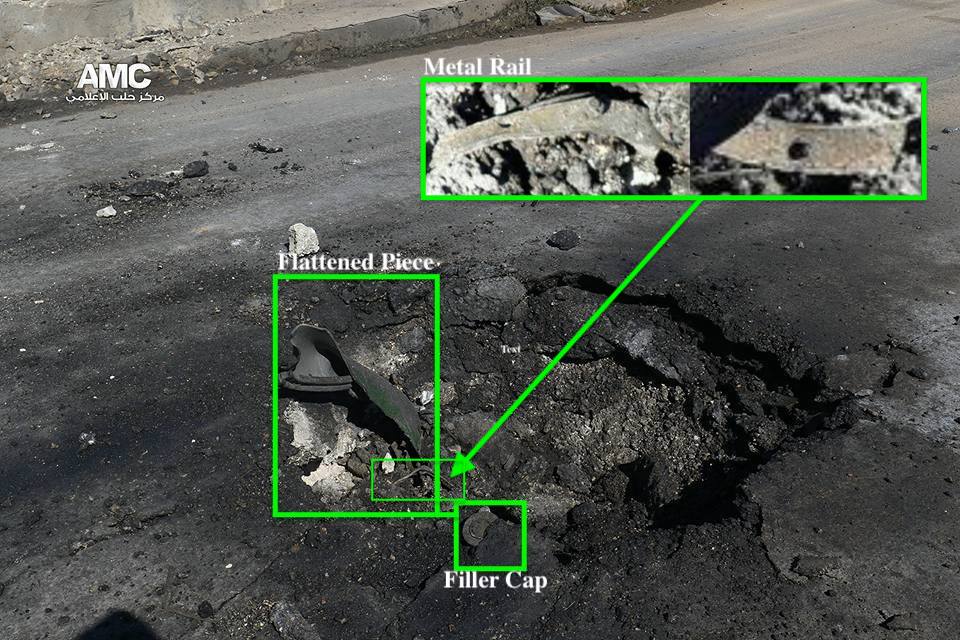
M4000?
In a September 24, 2019 article on Bellingcat, Higgins reveals what he claims are: “The First Images of the Type of Chemical Bomb Used in Syria’s Sarin Attacks”. From a short video cutting, he and Bod Trafford teamed up again, to model a munition from the video that Higgins claims is the M4000.

It is the view of the author that the uncovered munition bears a strong resemblance to the M4000 schematic presented at the Russian MoD press conference and whilst I will not take an absolutist position on it I will accept that it is the closest example that we have. I will, therefore, continue this report in that understanding.
Here is another image taken from the video:

Here is the video clip the images were taken from:
What we have here is a near-perfect example of what I believe to be an M4000 from 2013 in the hands of the opposition. This would lend credibility to the claims by the Syrian government that they had repurposed the M4000 for conventional use.
Foreign Policy’s Senior Diplomatic Reporter to the UN, Colum Lynch, was privy to a leaked report from the office of the Director-General of the OPCW. In that leaked document he notes:
The OPCW report also found that the Syrian government has failed to provide sufficient access to senior leaders in its chemical weapons program or to adequately account for 2,000 aerial bombs that Syria acknowledges were designed to chemical weapons. Syrian officials claim the bombs were converted into conventional explosives and dropped on enemy targets in 2013 as part of Syria’s civil war, but Uzumcu wrote that the lack of physical evidence makes it impossible to “verify that said bombs were repurposed and consumed.”
Emphasis mine
This example of an apparent M4000 in the hands of the opposition in 2013 would lend that claim evidential value.
Eliot then uncovered another video of, what looks like, an M4000 from 2014 and again in the hands of the opposition:
In this video we see a more retarded version with blown off tail section and a manually cut hole in the side of the payload body, assumably to take a look at its contents. It’s safe to say that its contents were not chemical in nature.
But what about the missing tail section? How would it have blown off in, what seems to be, perfect fashion? And does this share any relation with this section of the M4000 found in 2013?
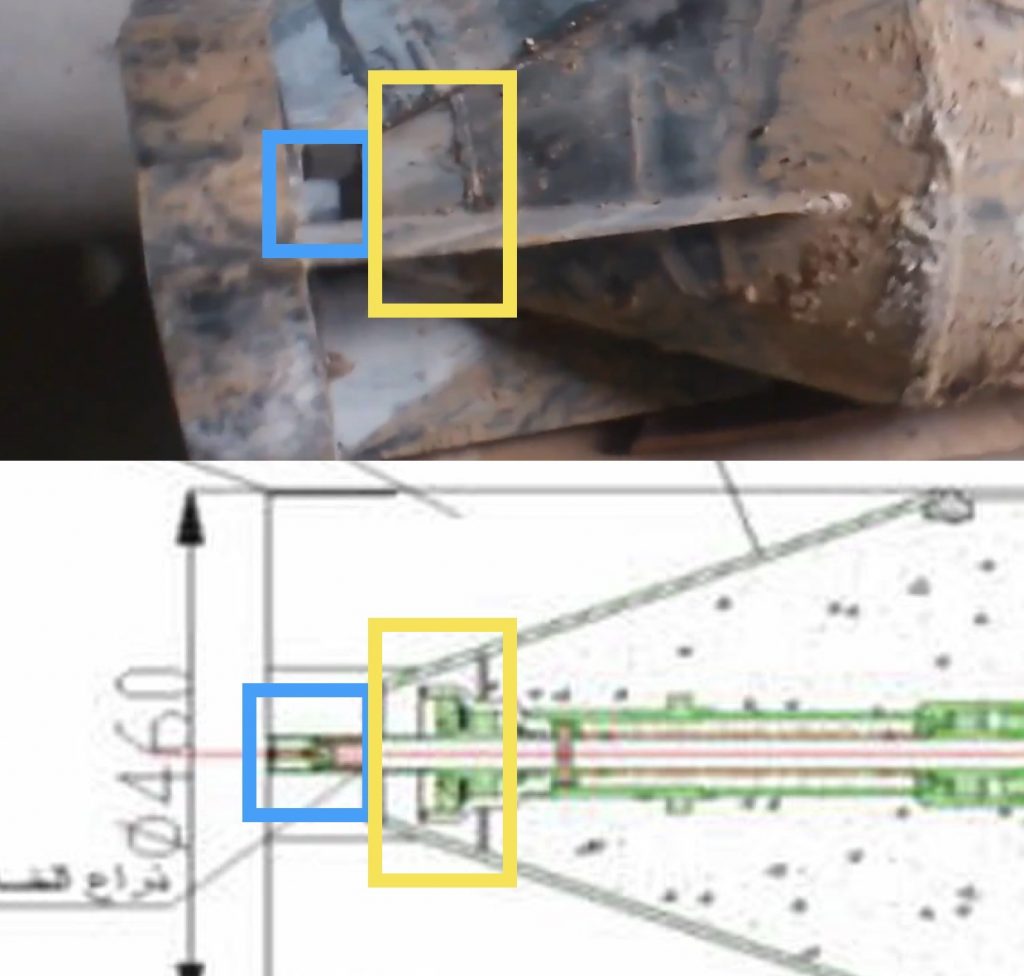
Top – A still from the April 2013 video (flipped for comparison purposes; Bottom – The Russian published diagram of the M4000 chemical bomb. The stirring arm is marked in blue, the housing for the stirring arm is marked in yellow
Eliot Higgins
I agree with Eliot that the top image does resemble the schematic quite well however the video of the M4000 with missing tail section made me ask the question if the Syrian military had added a tail fuse to the munition as part of its ‘repurposing’? That would certainly explain the missing tail section.
I had recalled seeing a Russian FAB 250 (M54 variant) with an impact fuse on the tail that had got me thinking how much like the schematic design of the M4000 this part of the bomb looked like. Then when I saw the video from Bellingcat I thought the idea of a tail fuse being added, in place of the mixing arm, to be a plausible concept. This munition also has an inertia fuse on the nose cone. This is only a theory I’m positing. I am not confirming it either way.
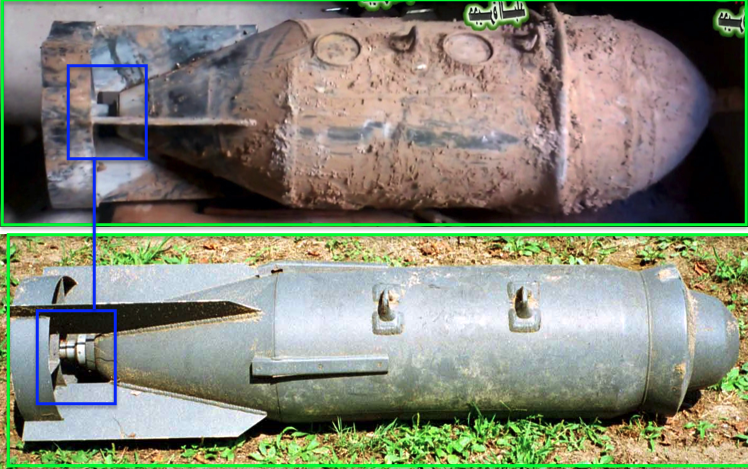
M4000 Videos – Conclusion
What the Higgins found videos tell us is that if these munitions are M4000’s then they had indeed been repurposed in 2013 and were being used
Al-Shayrat and Sarin
The M4000 was claimed to have come from and have been filled with sarin at the Al-Shayrat airbase when it was then loaded on to
There are several issues that present for this theory to be plausible. Firstly, Syria stored its sarin as precursors and not as an active agent as it did with Sulphur-Mustard. Those precursors are isopropanol and
Mixing these reagents for sarin is a dangerous and risky process, so much so this is why states choose to store the precursors separately and why Syria developed binary chemical munitions that would mix the reagents in flight. For this process, they had the MYM6000 which consisted of two chambers divided by a thin membrane, or partition. According to Scott Cairns who lead the team to dismantle Syria’s chemical infrastructure:
..the bombs contained two internal chambers separated by a thin membrane. When the bombs are filled with chemicals, activating them requires turning a crank attached to the back of the bomb, which rotates a rod inside, pierces the membrane and mixes the chemicals.
Scott Cairns, Inspections Team Lead
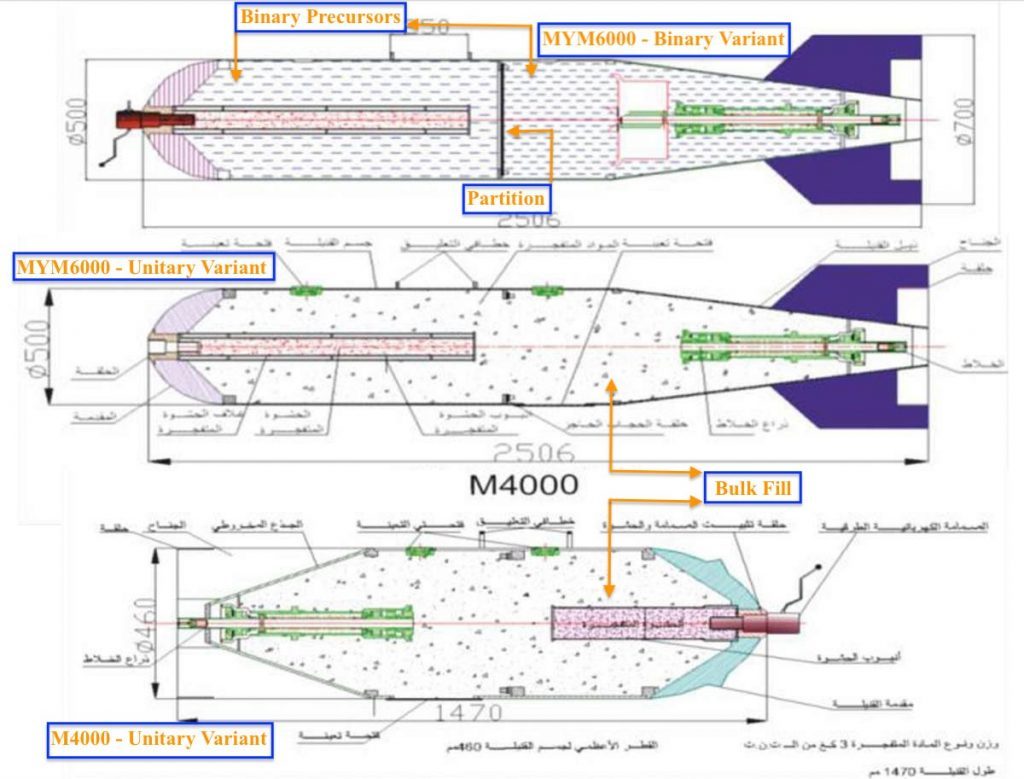
From the schematic, the role of the MYM6000 (top) was to mix sarin precursors in flight. The other two munitions depict active agent bulk filled munitions. This would explain why the M4000 was reported to the OPCW-DAT, by the Syrian government, as being used for Sulphur-Mustard. You will also note the “mixer” or “mixing paddle” in the drawing of the MYM6000 (top) as denoted by a red/pink rectangle.
Koblentz who has ties to the OPCW goes on to say:
“M4000 is only for bulk agent” says Gregory. This fits with the information on the schematic, and missing “mixing device”. It also fits with the Syrian claim, as noted, the M4000 was used for Sulphur-Mustard.
Initially, Higgins and Kaszeta were claiming the sarin was pre-mixed before being poured into the M4000, which, minus the proper mixing apparatus is

We know it wasn’t but as I’ve shown before, Eliot can be a bit liberal with the facts at times.
Even more recently, in his latest M4000 report, Higgins double-downs on his ‘M4000 is a binary munition’ notion by claiming the schematic drawing shows the sarin after it had been mixed in a binary munition.
The diagram of two types of Syrian chemical bomb, the MYM6000 and M4000. Note the top two images show the MYM6000 before and after the Sarin mixing process, and the bottom images shows the M4000 after the Sarin mixing process
Emphasis mine
The fact the schematic depicts the M4000 as unitary has now been ignored as Higgins moves away from the fixed and mobile mixing devices idea. Therefore, he needs the M4000 to be a binary munition to replace the loss of his previous theories.
This is the issue with Eliot’s type of investigation that we see time and time again. When the evidence doesn’t fit, he makes it fit. And nobody pulls him up on it. Fact free claims are abound in the world of Bellingcat.
However, the question must be asked again; why not just use the MYM6000 binary variant? There seems to be a huge attempt at trying to fit square pegs into round holes when there are round pegs that would fit much easier.
So what if M4000 unitary munition had its sarin premixed before being poured into the bomb? What would that process look like and what would it entail?
Gregory Koblentz writes in Foreign Policy on April 7, 2017:
Shayrat was also one of at least seven Syrian air bases that had the capability to load sarin or its precursors into bombs before these sites were dismantled by the OPCW.
Emphasis mine
Such Syrian capabilities were dismantled by the OPCW team lead, Scott Cairns, which concluded the dismantling process on the 23 June 2014.
According to the OPCW, Syria had:
eight mobile filling units, and three chemical weapons-related facilities
The OPCW said:
Syrian forces used cutting torches and angle grinders ‘to destroy’ munitions such as missile warheads and aerial bombs and disabling mobile and static mixing and filling units
Mobile Mixing Units
So what do these mobile mixing units look like and were they designed to mix sarin ‘on-the-go’ for aerial munitions?
Here is schematic from the Wall Street Journal “based upon information from people who have seen the equipment”. This was the only thing that I could find that gives us an idea of what they may have looked like:
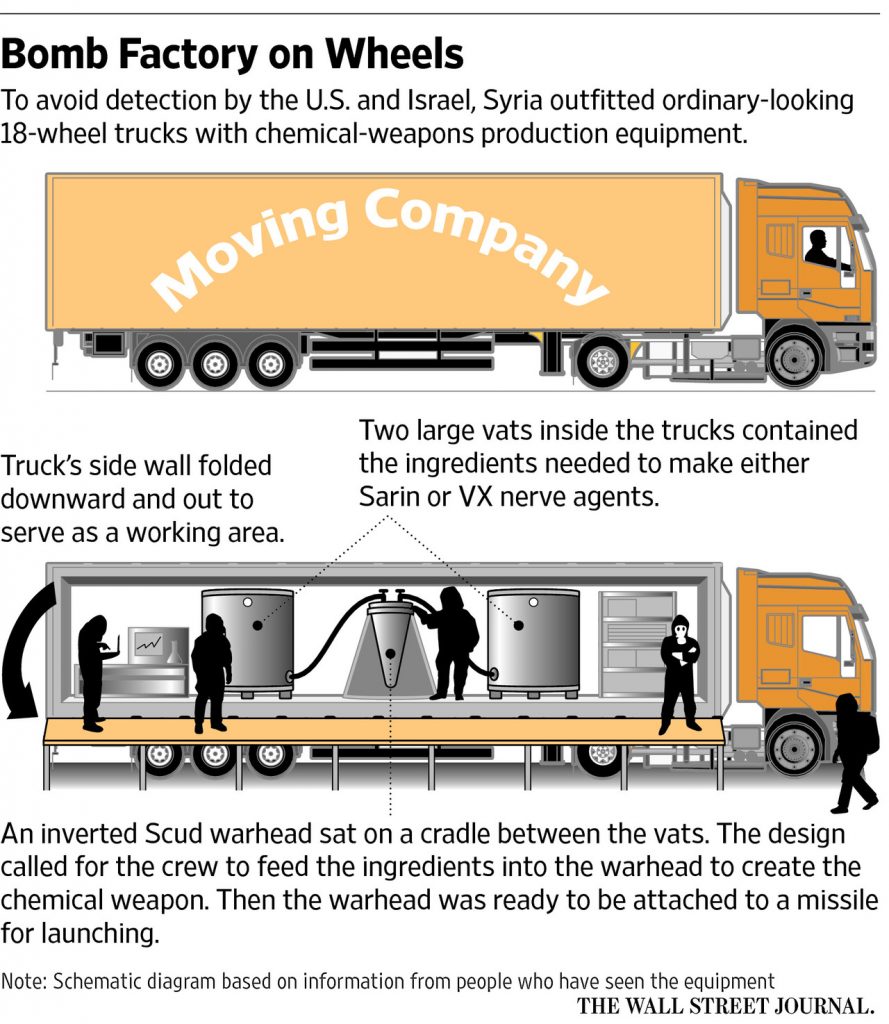
You will note the schematic shows a cradle for Scud-B missiles. Once filled, the filler caps would be tightened and the warhead attached to the rocket body. These units are not designed to fill aerial munitions. Why would they be? Syria had binary munitions for that purpose and why would you need to drive a lorry to an airfield when, as in Al-Shayrat, they once had fixed mixing devices? Yet we have no proof these fixed devices were even used to fill aerial munitions. It’s all too complicated and dangerous a procedure. Load the precursors into the MYM6000 binary munition, activate the crank, fit the fuse and load the bomb. Job
Recap on Shayrat Narrative
So the Syrian military used mixing devices they no longer have (as per the OPCW insider Koblentz) to mix sarin precursors. They then poured the sarin into a unitary bomb (as per Koblentz) [ludicrous and dangerous as an idea it is] loaded the M4000 onto an S
None of the remnants at the crater ever made it to the FFM or JIM investigators. Instead, the filler cap ended up with Human Rights Watch and the rail and flattened piece vanished, never to be seen again. Of this disappearing evidence Russia’s permanent representative to the UN says:
The fragments of the munition that were sticking out from the site of impact—we all saw them in video clips—have somehow disappeared. The FFM just took this for granted: well, what do you want? The munition fragments could not be retrieved—that’s that. We didn’t get an explanation any clearer than that. And so, the munition fragments were “secreted away” and he impact site was filled up with cement. It’s quite a challenge to see this as anything other than the destruction of critical material evidence. So sure, the “smokescreen” worked a treat after all.
Russian UN Ambassador – Alexander Shulgin – Emphasis mine
The OPCW-JIM also interviewed a “witness” who claimed:
A witness interviewed by the Mechanism, who reported having worked that morning as a spotter in Khan Shaykhun, recalled having received an alert concerning the take-off of a Su-22 from Sha‘irat airbase on the morning of 4 April 2017. The witness stated that the alert had advised residents to be careful, as the aircraft was likely carrying toxic chemicals.
Emphasis mine
The idea here seems to be that whilst monitoring the airwaves a spotter picked up chatter from an Su-22 that it had a chemical bomb onboard. Make of that claim what you may. I do wonder how that conversation would have played out between the pilot and the tower?
To some that may seem insensitive to those that lost their lives. To me, it perfectly sums up the ludicrousness we are being asked to believe.
Syrian and Russian Demands for OPCW to Visit Shayrat
Aron Lund, fellow at The Century Foundation, wrote in June 2017:
Legitimate questions have been raised about the U.S. claims about what happened in Khan Sheikhoun, including about the crater that American authorities say mark the spot where a chemical munition landed. That location seems difficult to square with the reported death toll, which I’m told by one expert would likely be lower, given the wind direction and other issues.
He goes on:
By contrast, the case of the Shayrat air base is one where the Russian-Syrian-Iranian arguments may be on firmer ground, and where some perceive Western governments as more focused on preserving face than on ensuring a thorough investigation.
Syrian Deputy Foreign Minister Faisal Meqdad sent an official invitation to the OPCW on April 11, encouraging the inspectors to visit both Khan Sheikhoun and Shayrat. Since then, Russia has continued to relentlessly pursue the issue of field visits, citing the failure to visit Khan Sheikhoun and Shayrat as evidence of that the investigation is corrupted.
The attack occurred on the April 4 and almost immediately the Syrians called for inspectors to visit the base to, apparently, prove the sarin didn’t come from there. The US & friends didn’t wait for the investigation and on April 7 launched a cruise missile strike.
I concur with Aron, I believe it would have been within everybody’s best interest for the OPCW to have despatched a team to Al-Shayrat in the immediate aftermath to either catch the Syrians in the act or not. Remember, the fixed mixing devices were destroyed. Mobile mixing devices weren’t suited to mixing sarin for aerial munitions, even if they were NATO satellite imagery would have picked up the movement of lorries to and from Shayrat. So if sarin was mixed at the base it would be easily picked up days after the event. If not sarin itself, its precursors and degradation products surely would be detectable.
Edmond Mulet, Head of the JIM, was reported in the UN News of November 7, 2017, as saying:
It [JIM] could not establish with certainty that the aircraft which delivered the chemical bomb had taken off from Al Shayrat air base, or the type of plane involved.
However, the OPCW-JIM did visit Al-Shayrat in October of 2017 but ‘refused to test for chemicals’ according to the Russian Ambassador:
After all the JIM did visit the airbase but flatly refused to take samples despite the presence of experienced OPCW chemists and the access to the necessary equipment
The visit was confirmed by Edmond Mulet in the same UN news article (above):
Technical teams visited Damascus and the Al-Shayrat airbase in September and October [2017]. Syria has engaged constructively with the Mechanism.
There does remain another vital unanswered question: Why didn’t the OPCW send a team to Al-Shayrat in the immediate aftermath of the Khan Sheikhoun attack?
On the reasons why they didn’t, Lund notes:
However, there seems to be less interest in visiting Shayrat, with several sources telling me the OPCW has decided that it would not be relevant to its mandate, which excludes the identification of perpetrators.
Formally, that’s true. But if Syrian authorities agree to welcome the inspectors, there is no evident reason Üzümcü could not dispatch a team to Shayrat—and the relevance of that site to the allegations of chemical weapons attacks in Syria is now undeniable.
Would you not expect Al-Shayrat would have been one of the very first places the OPCW would have demanded to see? The FFM had no problem in apportioning blame on Al-Lataminah when they concluded their report by saying:
Whilst the munition parts could not be categorically attributed to the allegation of 30 March 2017, their presence at the location, their contamination with sarin and sarin related chemicals, and features consistent with a chemical munition all lend themselves to the likelihood of their being involved in the deployment of a chemical weapon.
Who else could ‘deploy an aerial chemical weapon’ if not Syria or Russia? That was pointing towards apportioning blame right there. So this idea that by them visiting Shayrat to check for sarin would have been outside of their remit is farcical.
Khan Sheikhoun Sarin
If we can get passed all that and still believe the sarin came from an M4000 delivered by an Su-22 from Al-Shayrat airbase then we end up at the Khan Sheikhoun crater.
We know that the Syrian government obtained samples from the crater that they themselves tested positive for sarin. These samples were then given to the FFM who also found they tested positive for the chemical.
Then US Ambassador to the UN, Nikki Haley, declared to the UN:
In addition, the Syrian regime took samples it claimed were from Khan Shaykhun and provided them to the OPCW for analysis. Syria’s own samples confirmed the presence of sarin and match the samples that the OPCW collected in 2014 from the stockpile belonging to the Assad regime. These samples further diminished any benefit the FFM could gain from visiting the site.
So, in a nutshell, the official claim is that Syria provided the FFM with evidence of their own guilt.
Khan Sheikhoun Evidence
There are three notable pieces of debris of which images have been widely circulated.
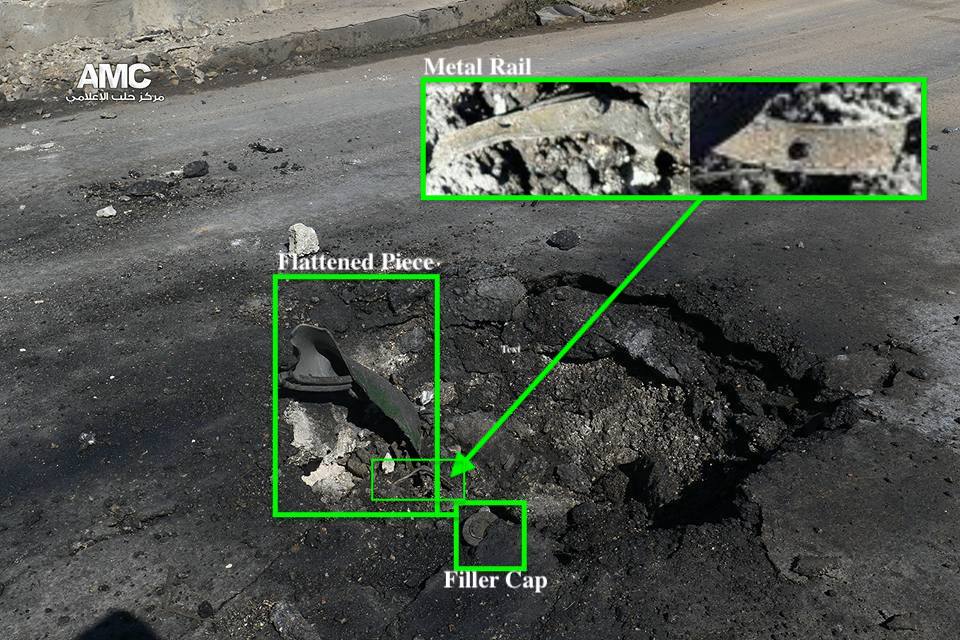
None of these 3 pieces found their way to either the FFM or JIM investigative teams. In a bizarre turn of events the filler cap ended up with Human Rights Watch (HRW) whilst the rail and flattened piece disappeared. Even if we accept they belong to the munition that delivered the sarin they don’t bear resemblance to pieces from the M4000. There’s no tail fin, fuse or any other relevant evidence apart from a filler cap that shares similarities with that of the M4000. But given the other remains cannot be accounted for, the placement of the filler cap in the crater doesn’t fit with the overall evidential values of everything else.
The Higgins Reversal
Initially, Eliot had declared with certainty that he “established a Syrian M4000 bomb was used…in Khan Sheikhoun”:

It is now to be welcomed that Eliot has walked back on part of his original assertion as he is now at least open to the idea that another munition may have been used instead. But what, or based upon what evidence, he doesn’t say:

Given that it was Eliot who gave life to the M4000 theory it’s important that he has now decided, what others have always suspected to be the case, there may not have been an M4000 used at all at Khan Sheikhoun!
But if there’s no evidence of an M4000 being used there, there is certainly less
Conclusion
It is hard to see how the official narrative holds up under scrutiny. The US, France & UK said the Su-22 took off from Al-Shayrat. This was also the claim made by the White Helmets and aircraft spotters. The head of the OPCW-JIM said he couldn’t say for sure. Syria agreed it had 2 jets in the sky at that time but the nearest they were to Khan Sheikhoun was 5km away. The jet that is alleged to have dropped the fateful bomb was of these two and seemingly flying in the opposite direction of the town at the time it was said to have launched the bomb.
Originally Eliot Higgins and, self-styled chemical weapons expert, Dan Kaszeta claimed the sarin was mixed before it was poured into the M4000. After realising how mad of an idea that was they have changed that to the sarin was mixed in a bomb on the ground before being loaded onto the jet. The problem with this theory is that the bomb in question was a bulk filled unit designed for a single active ingredient, not for mixing. This didn’t stop Higgins changing the bomb type from a unitary, bulk filled unit, to a binary, reagent filled unit, just like that. As I have shown, all available evidence points to the M4000 being a unitary filled bomb – therefore sarin can not be mixed in it.
The premixing idea using either mobile or fixed mixing devices has been shown to be untenable given both had been destroyed by the OPCW. Even if we are to assume that Assad hid a mobile device or two we have seen how they aren’t designed for aerial munitions filling. If we are to assume they were refitted to be suitable we would then have to ascertain how several hundred KGs of bomb and filling could be lifted from a mobile device to the aircraft and more importantly, why this would be necessary? Just use the MYM6000 binary munition. It’s safe, designed for the purpose and doesn’t require a huge conspiracy theory to make happen.
Given the M4000 is, as said, a unitary munition the sarin would have had to have been mixed before it was poured into the bomb.
Then there’s the lack of debris relating to an M4000 at Khan Sheikhoun; the evidence that disappeared; the filler cap that went to HRW (and not the OPCW) and the uncertainty by the OPCW-JIM that the jet used came from Shayrat.
But there is a new dimension now to the debate on the filler cap. It has long been argued by those supporting the airdropped chemical bomb theory that the only way the filler cap could have gotten into the crater was from an airdropped chemical bomb. Now we have proof, thanks to Eliot Higgins, that the opposition had the remains of at least two of these bombs, filler caps included, since 2013. This is something nobody could prove until now. So it is no longer a conspiracy theory to hypothesise that one of these groups may have dropped a filler cap into the crater.
From the Higgins find we now also have proof that the Syrian government had, as they claimed, repurposed the M4000 for conventional use since at least 2013, possibly before. Bear in mind that not until 2017 had there been a claim of an aerial sarin attack by any actor in Syria. So one could logically ask why the Syrian military wouldn’t have used the munitions before then and why did they wait 4 years to do so after claiming to have repurposed them?
In conclusion, having analysed the available evidence it is clear that evidence, and lack-there-of, does not support the claim that an M4000 was used at Khan Sheikhoun on April 4, 2017.
Nor does the evidence support the claim binary sarin could have been deployed from al-Shayrat.
Next up: M4000 – The Sarin Deception – Part 4
Lataminah: Rails, Caps and the M4000

The “flattened piece” was apparently just left stuck in the road:
https://youtu.be/jSHhCjyK6fo?t=37
Mulet told 60 Minutes the JIM had the pilot recordings too, this wasn’t worth a mention in their actual report. Last video here (now paywalled):
https://www.cbsnews.com/news/what-a-chemical-attack-in-syria-looks-like-60-minutes/
Good find on the flattened piece being covered in concrete. I will add that to the report, thanks.